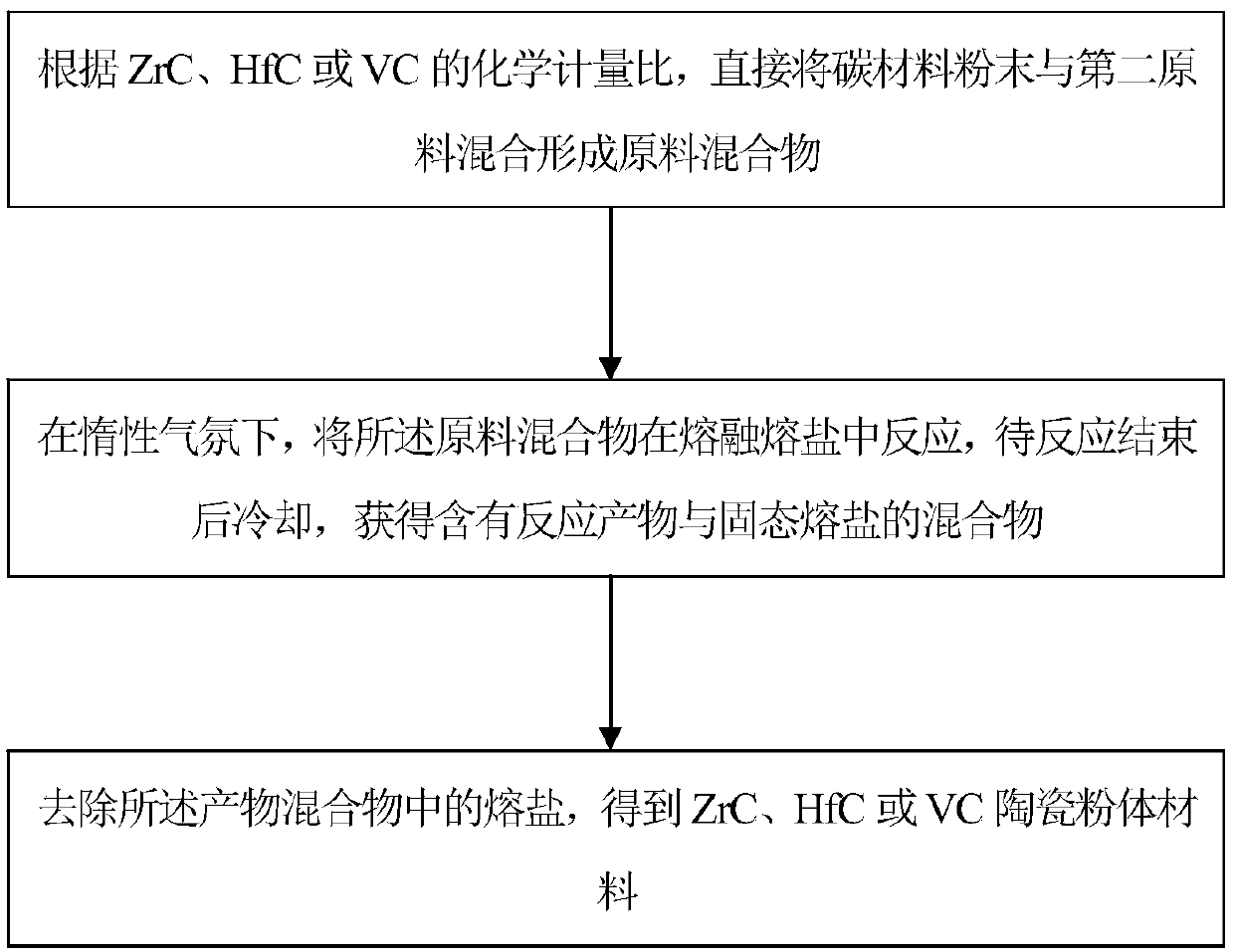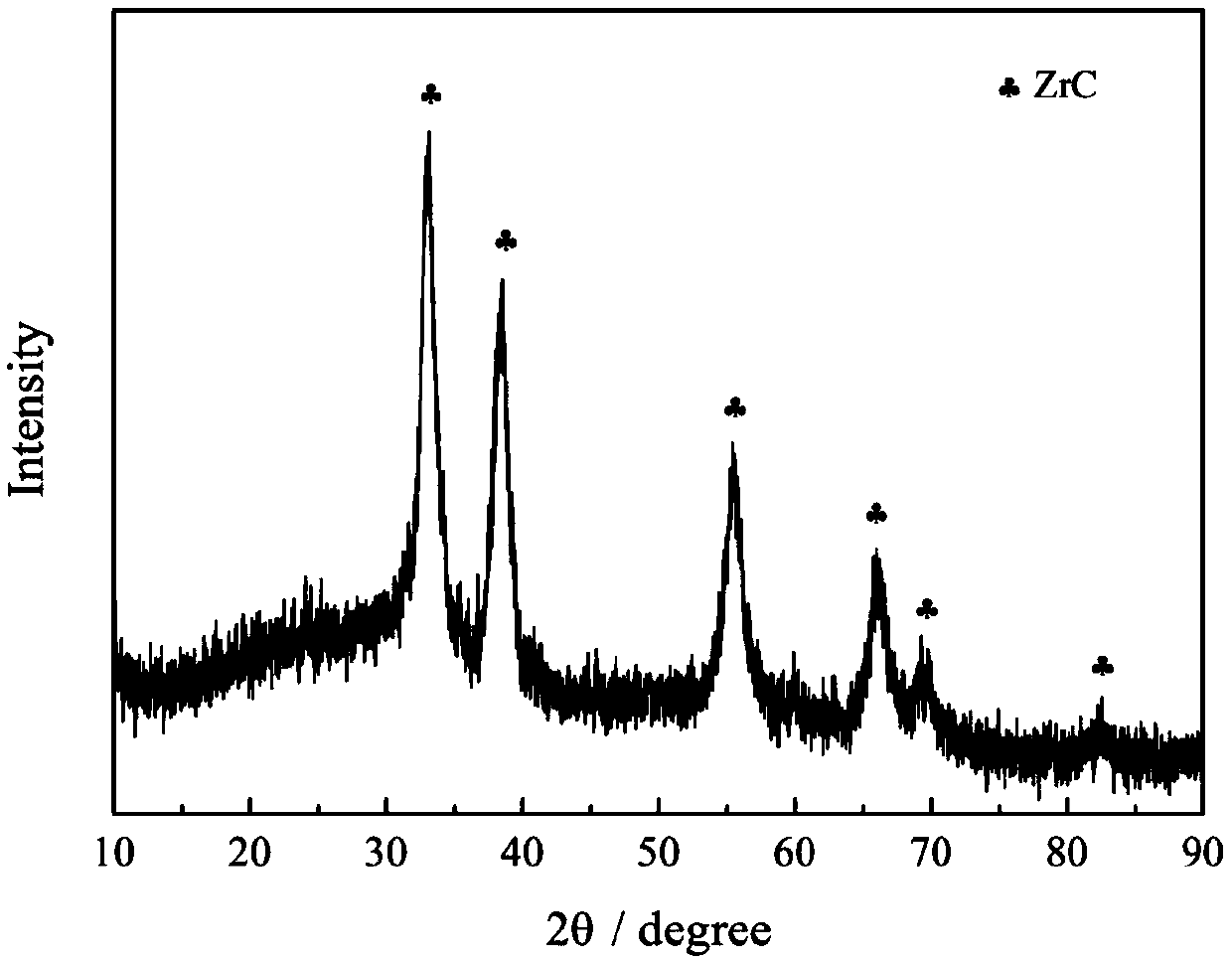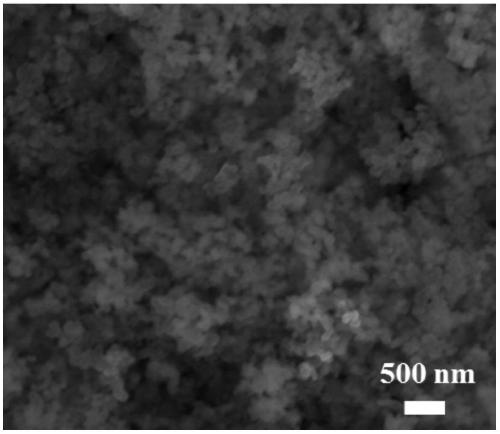Method for in-situ preparation of zirconium, hafnium or vanadium carbide powder by molten salt disproportionation reaction
A disproportionation reaction and in-situ preparation technology, which is applied in the field of HfC or VC powder to prepare ZrC, can solve the problems of complex preparation process and equipment, difficult control of shape and size, high synthesis temperature, etc., and achieve low raw material cost and process cost , product shape and size controllable, simple process effect
- Summary
- Abstract
- Description
- Claims
- Application Information
AI Technical Summary
Problems solved by technology
Method used
Image
Examples
Embodiment 1
[0049] In this embodiment, weigh 50 unit weight of LiCl-KCl eutectic salt, and mix with 3.0 unit weight of Zr powder (200 mesh), 0.4 unit weight of nano-scale acetylene black powder (average particle size 40nm), and place the mixture in In a corundum crucible. The above crucible was placed in a stainless steel reactor, sealed and protected by Ar gas. Use a temperature controller to raise the temperature to 940°C at a rate of 10°C / min, keep it at this temperature for 2 hours, then turn off the power and cool down to room temperature with the furnace. The obtained product was taken out, soaked and rinsed with deionized water to remove residual molten salt, and then dried at 80° C. to obtain ZrC nanometer powder.
[0050] The obtained target product is tested, and its XRD pattern and SEM photo are respectively as follows figure 2 and 3 shown. Depend on figure 2 and 3 It can be seen that the obtained nano-powder is ZrC, and after further testing, the particle size of the Z...
Embodiment 2
[0052] In the present embodiment, weigh 20 unit weight of KF-KCl eutectic salt, and mix with 3.0 unit weight of Zr powder (325 mesh), 0.68 unit weight of NH 4 Cl, 0.4 unit weight of graphite flakes (average particle size 500nm) were mixed, and the mixture was placed in a corundum crucible. The above crucible was placed in a stainless steel reactor, sealed and protected by Ar gas. Use a temperature controller to raise the temperature to 880°C at a rate of 8°C / min, keep at this temperature for 3 hours, and then turn off the power and cool down to room temperature with the furnace. The obtained product is taken out, soaked and rinsed with deionized water to remove residual molten salt, and then dried at 120°C to obtain ZrC nanopowder. The ZrC nanopowder in the obtained product has a particle size of 500-700nm and a purity of 98.5wt%.
Embodiment 3
[0054] In this embodiment, weigh 30 unit weights of NaCl-KCl eutectic salt, mix with 4.3 unit weights of V powder (325 mesh), 1.0 unit weights of acetylene black (average particle size 40nm), and place the mixture in a corundum crucible . The above crucible was placed in a stainless steel reactor, sealed and protected by Ar gas. Use a temperature controller to raise the temperature to 950°C at a rate of 5°C / min, keep it at this temperature for 4 hours, then turn off the power and cool down to room temperature with the furnace. The resulting product was taken out, rinsed with deionized water to remove residual molten salt, then dried at 80°C, and detected by XRD and SEM as follows: Figure 4 and 5 As shown, the target product is VC nanopowder, and the particle size of VC nanopowder in the obtained product is 50-80nm, and the purity is 98wt%.
[0055] In addition, it has been tested that the obtained ZrC nanopowders and VC nanopowders have excellent hydrophilicity and dispers...
PUM
| Property | Measurement | Unit |
|---|---|---|
| particle size | aaaaa | aaaaa |
| particle size | aaaaa | aaaaa |
| particle size | aaaaa | aaaaa |
Abstract
Description
Claims
Application Information
 Login to View More
Login to View More - R&D
- Intellectual Property
- Life Sciences
- Materials
- Tech Scout
- Unparalleled Data Quality
- Higher Quality Content
- 60% Fewer Hallucinations
Browse by: Latest US Patents, China's latest patents, Technical Efficacy Thesaurus, Application Domain, Technology Topic, Popular Technical Reports.
© 2025 PatSnap. All rights reserved.Legal|Privacy policy|Modern Slavery Act Transparency Statement|Sitemap|About US| Contact US: help@patsnap.com



